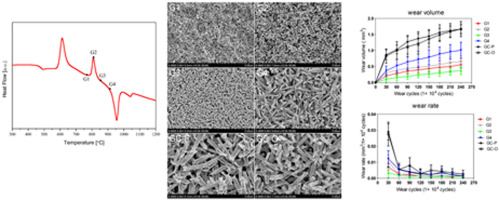Journal of the Mechanical Behavior of Biomedical Materials ( IF 3.3 ) Pub Date : 2018-02-20 , DOI: 10.1016/j.jmbbm.2018.02.023 Zhenzhen Zhang , Jiawen Guo , Yali Sun , Beimin Tian , Xiaojuan Zheng , Ming Zhou , Lin He , Shaofeng Zhang

|
Objectives
The purpose of this study is to improve wear resistance and mechanical properties of lithium disilicate glass-ceramics by refining their crystal sizes.
Methods
After lithium disilicate glass-ceramics (LD) were melted to form precursory glass blocks, bar (N = 40, n = 10) and plate (N = 32, n = 8) specimens were prepared. According to the differential scanning calorimetry (DSC) of precursory glass, specimens G1–G4 were designed to form lithium disilicate glass-ceramics with different crystal sizes using a two-step thermal treatment. In the meantime, heat-pressed lithium disilicate glass-ceramics (GC-P) and original ingots (GC-O) were used as control groups. Glass-ceramics were characterized using X-ray diffraction (XRD) and were tested using flexural strength test, nanoindentation test and toughness measurements. The plate specimens were dynamically loaded in a chewing simulator with 350 N up to 2.4 × 106 loading cycles. The wear analysis of glass-ceramics was performed using a 3D profilometer after every 300,000 wear cycles. Wear morphologies and microstructures were analyzed by scanning electron microscopy (SEM). One-way analysis of variance (ANOVA) was used to analyze the data. Multiple pairwise comparisons of means were performed by Tukey's post-hoc test.
Results
Materials with different crystal sizes (p < 0.05) exhibited different properties. Specifically, G3 with medium-sized crystals presented the highest flexural strength, hardness, elastic modulus and fracture toughness. G1 and G2 with small-sized crystals showed lower flexural strength, whereas G4, GC-P, and GC-O with large-sized crystals exhibited lower hardness and elastic modulus. The wear behaviors of all six groups showed running-in wear stage and steady wear stage. G3 showed the best wear resistance while GC-P and GC-O exhibited the highest wear volume loss.
Conclusions
After crystal refining, lithium disilicate glass-ceramic with medium-sized crystals showed the highest wear resistance and mechanical properties.
中文翻译:

晶体细化对二硅酸锂玻璃陶瓷的磨损行为和力学性能的影响
目标
这项研究的目的是通过细化晶体大小来提高二硅酸锂玻璃陶瓷的耐磨性和机械性能。
方法
将二硅酸锂玻璃陶瓷(LD)熔化以形成前体玻璃块后,准备棒材(N = 40,n = 10)和板材(N = 32,n = 8)样品。根据前体玻璃的差示扫描量热法(DSC),将样品G1-G4设计为通过两步热处理形成具有不同晶体尺寸的二硅酸锂玻璃陶瓷。同时,将热压二硅酸锂玻璃陶瓷(GC-P)和原始锭(GC-O)用作对照组。使用X射线衍射(XRD)表征玻璃陶瓷,并使用抗弯强度测试,纳米压痕测试和韧性测量进行测试。将板状样品动态加载到350 N的咀嚼模拟器中,最大载荷为2.4×10 6加载周期。每300,000次磨损循环后,使用3D轮廓仪进行玻璃陶瓷的磨损分析。磨损形态和微观结构通过扫描电子显微镜(SEM)进行分析。使用单向方差分析(ANOVA)来分析数据。通过Tukey的事后检验对均值进行多个成对比较。
结果
具有不同晶体尺寸(p <0.05)的材料表现出不同的性能。具体而言,具有中等尺寸晶体的G3表现出最高的弯曲强度,硬度,弹性模量和断裂韧性。具有小尺寸晶体的G1和G2表现出较低的抗弯强度,而具有大尺寸晶体的G4,GC-P和GC-O具有较低的硬度和弹性模量。六个组的磨损行为均显示为磨合磨损阶段和稳定磨损阶段。G3表现出最佳的耐磨性,而GC-P和GC-O表现出最高的磨损量损失。
结论
晶体细化后,具有中等尺寸晶体的二硅酸锂玻璃陶瓷显示出最高的耐磨性和机械性能。











































 京公网安备 11010802027423号
京公网安备 11010802027423号